

Compact Muon Solenoid
LHC, CERN
| CMS-HIN-15-012 ; CERN-EP-2016-274 | ||
| Measurements of the charm jet cross section and nuclear modification factor in pPb collisions at $\sqrt{ s_{\mathrm{NN}} } =$ 5.02 TeV | ||
| CMS Collaboration | ||
| 29 December 2016 | ||
| Phys. Lett. B 772 (2017) 306 | ||
| Abstract: The CMS Collaboration presents the first measurement of the differential cross section of jets from charm quarks produced in proton-lead (pPb) collisions at a nucleon-nucleon center-of-mass energy of $\sqrt{ s_{\mathrm{NN}} } =$ 5.02 TeV, as well as results from charm quark jets in proton-proton (pp) collisions at $\sqrt{s} =$ 2.76 and 5.02 TeV. By comparing the yields of the pPb and pp collision systems at the same energy, a nuclear modification factor for charm jets in pPb collisions at $\sqrt{ s_{\mathrm{NN}} } =$ 5.02 TeV of $R_{\mathrm{ p }\mathrm{A}} =$ 0.92 $\pm$ 0.07 (stat) $\pm$ 0.11 (syst) is obtained. This is consistent with an absence of final-state energy loss for charm quarks in pPb collisions. In addition, the fraction of jets coming from charm quarks is found to be consistent with that predicted by PYTHIA 6 for pp collisions at $\sqrt{s} = $ 2.76 and 5.02 TeV, and is independent of the jet transverse momentum from 55 to 400 GeV/$c$. | ||
| Links: e-print arXiv:1612.08972 [nucl-ex] (PDF) ; CDS record ; inSPIRE record ; HepData record ; CADI line (restricted) ; | ||
| Figures | |

png pdf |
Figure 1:
Efficiency of tagging b jets (left) and light parton jets (right) for the high-purity (3+track), and high-efficiency (2+track) versions of the simple secondary vertex (SSV) tagger as a function of c jet tagging efficiency. The charm-to-bottom discrimination power is virtually unchanged between the high-efficiency and high-purity versions of the tagger, while the light parton jet mistag rate is reduced by a factor of three at the analysis working point, shown as the closed red cross on the plots. |

png pdf |
Figure 2:
Corrected secondary vertex mass distributions from PYTHIA+HIJING for c jets (green), light parton jets (blue), and b jets (red) in the jet ${p_{\mathrm {T}}}$ range 55-80 GeV/$c$ (left) and 120-170 GeV/$c$ (right). Relative normalizations of these three distributions are fit to a distribution from pPb collision data (black). Statistical uncertainties are shown in black for data and for individual simulated flavor components and are shown in blue for the sum of the simulated distribution. The bottom panels of both plots show the ratio of data to simulation. |

png pdf |
Figure 2-a:
Corrected secondary vertex mass distributions from PYTHIA+HIJING for c jets (green), light parton jets (blue), and b jets (red) in the jet ${p_{\mathrm {T}}}$ range 55-80 GeV/$c$. Relative normalizations of these three distributions are fit to a distribution from pPb collision data (black). Statistical uncertainties are shown in black for data and for individual simulated flavor components and are shown in blue for the sum of the simulated distribution. The bottom panel shows the ratio of data to simulation. |

png pdf |
Figure 2-b:
Corrected secondary vertex mass distributions from PYTHIA+HIJING for c jets (green), light parton jets (blue), and b jets (red) in the jet ${p_{\mathrm {T}}}$ range 120-170 GeV/$c$. Relative normalizations of these three distributions are fit to a distribution from pPb collision data (black). Statistical uncertainties are shown in black for data and for individual simulated flavor components and are shown in blue for the sum of the simulated distribution. The bottom panel shows the ratio of data to simulation. |

png pdf |
Figure 3:
Corrected secondary vertex mass from a PYTHIA-6, tune Z2 simulation for c jets (green), light parton jets (blue) and b jets (red) in the jet ${p_{\mathrm {T}}}$ range 55-80 GeV/$c$ (left) and 120-170 GeV/$c$ (right). Relative normalizations of these three distributions are fit to a distribution from pp collision data (black). Statistical uncertainties are shown in black for data and for individual simulated flavor components and are shown in blue for the sum of the simulated distribution. The bottom panels of both plots show the ratio of data to simulation. |
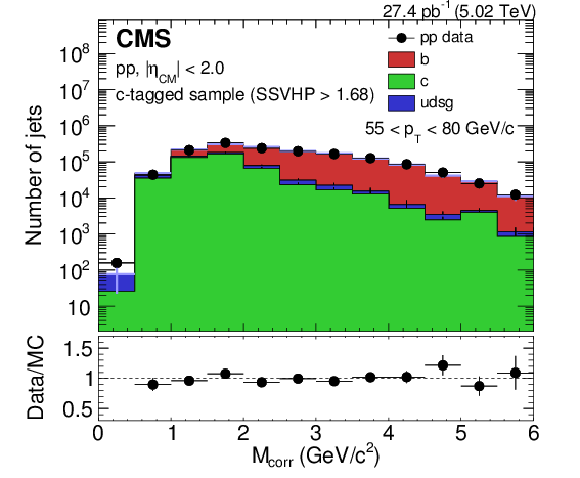
png pdf |
Figure 3-a:
Corrected secondary vertex mass from a PYTHIA-6, tune Z2 simulation for c jets (green), light parton jets (blue) and b jets (red) in the jet ${p_{\mathrm {T}}}$ range 55-80 GeV/$c$. Relative normalizations of these three distributions are fit to a distribution from pp collision data (black). Statistical uncertainties are shown in black for data and for individual simulated flavor components and are shown in blue for the sum of the simulated distribution. The bottom panel shows the ratio of data to simulation. |
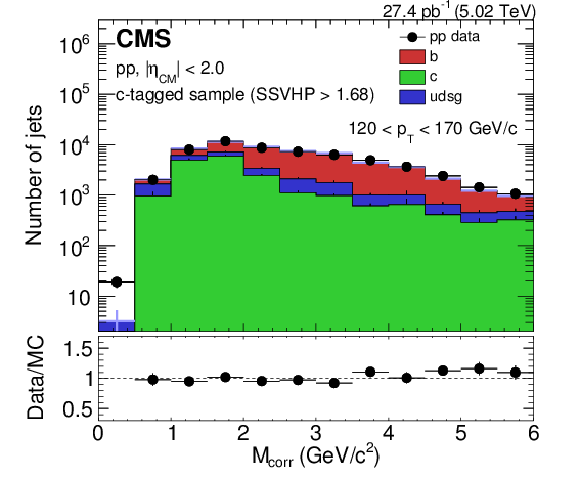
png pdf |
Figure 3-b:
Corrected secondary vertex mass from a PYTHIA-6, tune Z2 simulation for c jets (green), light parton jets (blue) and b jets (red) in the jet ${p_{\mathrm {T}}}$ range 120-170 GeV/$c$. Relative normalizations of these three distributions are fit to a distribution from pp collision data (black). Statistical uncertainties are shown in black for data and for individual simulated flavor components and are shown in blue for the sum of the simulated distribution. The bottom panel shows the ratio of data to simulation. |

png pdf |
Figure 4:
Tagging purity (left) and efficiency (right) for the working point selection of $\mathrm {SSVHP} > $ 1.68 in pPb collisions at 5.02 TeV for simulation (open red squares) and data (closed black points). |

png pdf |
Figure 4-a:
Tagging purity for the working point selection of $\mathrm {SSVHP} > $ 1.68 in pPb collisions at 5.02 TeV for simulation (open red squares) and data (closed black points). |

png pdf |
Figure 4-b:
The efficiency (right) for the working point selection of $\mathrm {SSVHP} > $ 1.68 in pPb collisions at 5.02 TeV for simulation (open red squares) and data (closed black points). |

png pdf |
Figure 5:
The tagging purity (left) and efficiency (right) for the working point selection of $\mathrm {SSVHP} > $ 1.68 in pp collisions at 5.02 TeV (square markers) and at 2.76 TeV (circular markers). Purity curves from simulation (open red markers) and data (closed markers) are shown, obtained by fitting templates to the data. The right plot shows efficiency curves from simulation (open red markers) and the cross-check based on JP tagging. |
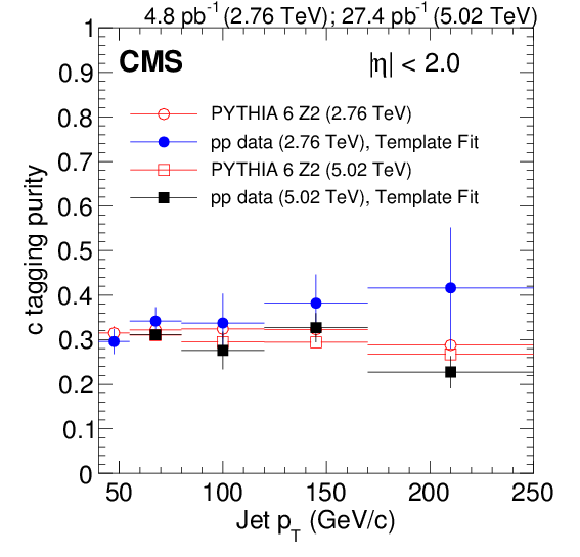
png pdf |
Figure 5-a:
The tagging purity for the working point selection of $\mathrm {SSVHP} > $ 1.68 in pp collisions at 5.02 TeV (square markers) and at 2.76 TeV (circular markers). Purity curves from simulation (open red markers) and data (closed markers) are shown, obtained by fitting templates to the data. |

png pdf |
Figure 5-b:
The efficiency for the working point selection of $\mathrm {SSVHP} > $ 1.68 in pp collisions at 5.02 TeV (square markers) and at 2.76 TeV (circular markers). The plot shows efficiency curves from simulation (open red markers) and the cross-check based on JP tagging. |
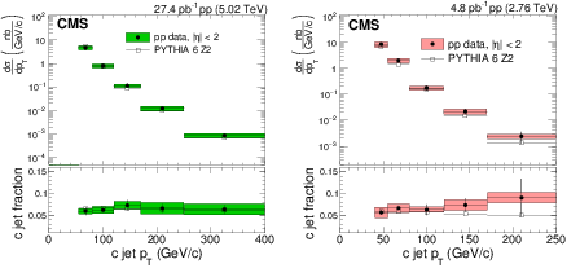
png pdf |
Figure 6:
The c jet spectra (top) and fraction (bottom) as a function of c jet ${p_{\mathrm {T}}}$ for 5.02 TeV (left) and 2.76 TeV pp data (right), compared to predictions from PYTHIA-6. Systematic uncertainties are shown as filled boxes. |

png pdf |
Figure 6-a:
The c jet spectra (top) and fraction (bottom) as a function of c jet ${p_{\mathrm {T}}}$ for 5.02 TeV pp data, compared to predictions from PYTHIA-6. Systematic uncertainties are shown as filled boxes. |

png pdf |
Figure 6-b:
The c jet spectra (top) and fraction (bottom) as a function of c jet ${p_{\mathrm {T}}}$ for 2.76 TeV pp data, compared to predictions from PYTHIA-6. Systematic uncertainties are shown as filled boxes. |
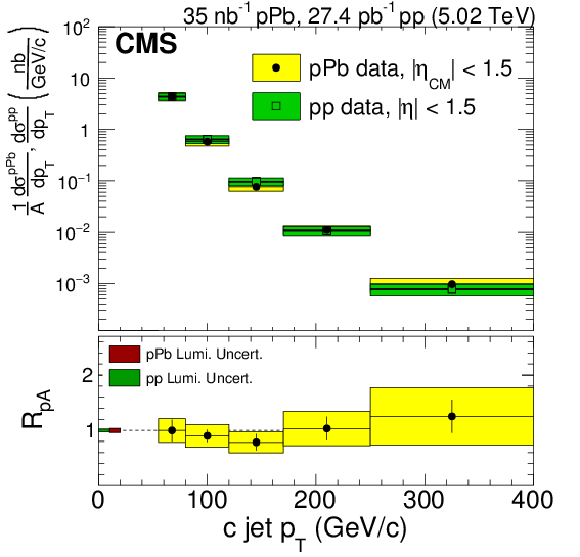
png pdf |
Figure 7:
The c jet spectrum (top) and ${R_{\mathrm{ p } \mathrm {A}}}$ (bottom) as a function of c jet ${p_{\mathrm {T}}}$ for 5.02 TeV pPb and pp data. Statistical uncertainties are solid black lines, while systematic uncertainties are shown as filled colored boxes. Integrated luminosity uncertainties for pp and pPb data are shown as filled boxes around unity. |
| Summary |
| The transverse momentum differential cross-section for c jets has been obtained for pPb collisions at $\sqrt{ s_{\mathrm{NN}} }= $ 5.02 TeV, as well as for pp collisions at $\sqrt{s} = $ 2.76 and 5.02 TeV. The c jet fraction of $\approx$6% is consistent with PYTHIA simulations for pp collisions at both center-of-mass energies. By comparing the cross sections for pPb and pp collisions, a $p_{\mathrm{T}}$-independent ${R_{\mathrm{ p }\mathrm{A}}} $ value of 0.92 $\pm$ 0.07 (stat) $\pm$ 0.11 (syst) is observed for c jets at 5.02 TeV, indicating that no significant jet energy modification is present in pPb collisions for c jets with $p_{\mathrm{T}}> $ 55 GeV/$c$. These measurements indicate that proton-lead initial state effects on c jets between 55-400 GeV/$c$ are small and that charm jet quenching in lead-lead collisions should not be influenced by such effects. |
| References | ||||
| 1 | F. Karsch | Lattice results on QCD thermodynamics | NP A 698 (2002) 199 | hep-ph/0103314 |
| 2 | STAR Collaboration | Experimental and theoretical challenges in the search for the quark gluon plasma: The STAR collaboration's critical assessment of the evidence from RHIC collisions | NP A 757 (2005) 102 | nucl-ex/0501009 |
| 3 | B. W. Berndt Muller, Jurgen Schukraft | First results from Pb+Pb collisions at the LHC | Ann. Rev. of Nuc. and Part. Sci. 62 (2012) 361 | 1202.3233 |
| 4 | CMS Collaboration | Measurement of the pseudorapidity and centrality dependence of the transverse energy density in PbPb collisions at $ \sqrt{s_{_\mathrm{NN}}} = $ 2.76 TeV | PRL 109 (2012) 152303 | |
| 5 | PHENIX Collaboration | Transverse energy production and charged-particle multiplicity at midrapidity in various systems from $ \sqrt{s_{NN}}= $ 7.7 to 200 GeV | PRC 93 (2016), no. 2, 024901 | 1509.06727 |
| 6 | J. D. Bjorken | Energy loss of energetic partons in QGP: possible extinction of high $ {p_{\mathrm{T}}} $ jets in hadron-hadron collisions | FERMILAB-PUB-82-059-THY | |
| 7 | PHENIX Collaboration | Formation of dense partonic matter in relativistic nucleus nucleus collisions at RHIC: Experimental evaluation by the PHENIX collaboration | NP A 757 (2005) 184 | nucl-ex/0410003 |
| 8 | PHOBOS Collaboration | The PHOBOS perspective on discoveries at RHIC | NP A 757 (2005) 28 | nucl-ex/0410022 |
| 9 | BRAHMS Collaboration | Quark gluon plasma and color glass condensate at RHIC? the perspective from the BRAHMS experiment | NP A 757 (2005) 1 | nucl-ex/0410020 |
| 10 | CMS Collaboration | Observation and studies of jet quenching in PbPb collisions at nucleon-nucleon center-of-mass energy = 2.76 TeV | PRC 84 (2011) 024906 | CMS-HIN-10-004 1102.1957 |
| 11 | ATLAS Collaboration | Observation of a centrality-dependent dijet asymmetry in lead-lead collisions at $ \sqrt{s_{NN}} = $ 2.76 TeV with the ATLAS detector at the LHC | PRL 105 (2010) 252303 | 1011.6182 |
| 12 | ALICE Collaboration | Measurement of charged jet suppression in Pb-Pb collisions at $ \sqrt{s_{NN}} = $ 2.76 TeV | JHEP 30 (2014) 013 | 1311.0633 |
| 13 | ALICE Collaboration | Centrality dependence of charged jet production in p-Pb collisions at $ \sqrt{s_{NN}} = $ 5.02 TeV | EPJC 76 (2016) 271 | 1603.03402 |
| 14 | H. van Hees and R. Rapp | Thermalization of heavy quarks in the quark-gluon plasma | PRC 71 (2005) 034907 | nucl-th/0412015 |
| 15 | G. D. Moore and D. Teaney | How much do heavy quarks thermalize in a heavy ion collision? | PRC 71 (2005) 064904 | hep-ph/0412346 |
| 16 | J. Huang, Z. B. Kang, and I. Vitev | Inclusive b-jet production in heavy ion collisions at the LHC | PLB 726 (2013) 251 | 1306.0909 |
| 17 | Y. L. Dokshitzer and D. E. Kharzeev | Heavy quark calorimetry of QCD matter | PLB 519 (2001) 199 | hep-ph/0106202 |
| 18 | T. Sjostrand, S. Mrenna, and P. Skands | PYTHIA 6.4 physics and manual | JHEP 05 (2006) 026 | hep-ph/0603175 |
| 19 | D. d'Enterria | Jet quenching | ch. 6.4 Springer Materials | 0902.2011 |
| 20 | A. Banfi, G. P. Salam, and G. Zanderighi | Accurate QCD predictions for heavy-quark jets at the Tevatron and LHC | JHEP 07 (2007) 026 | 0704.2999 |
| 21 | CMS Collaboration | Study of B meson production in $ p+\mathrm{Pb} $ collisions at $ \sqrt{s_{NN}} = $ 5.02 TeV using exclusive hadronic decays | PRL 116 (2016) 032301 | CMS-HIN-14-004 1508.06678 |
| 22 | CMS Collaboration | Studies of dijet transverse momentum balance and pseudorapidity distributions in pPb collisions at $ \sqrt{s_\mathrm{NN}}= $ 5.02 TeV | EPJC 74 (2014) 2951 | |
| 23 | CMS Collaboration | Measurement of inclusive jet nuclear modification factor in pPb collisions at $ \sqrt{s_{NN}} = $ 5.02 tev | EPJC 76 (2016) 372 | CMS-HIN-14-001 1601.02001 |
| 24 | ATLAS Collaboration | Centrality and rapidity dependence of inclusive jet production in $ \sqrt{s_{NN}} = $ 5.02 TeV proton-lead collisions with the ATLAS detector | PLB 748 (2015) 392 | 1412.4092 |
| 25 | ALICE Collaboration | Measurement of charged jet production cross sections and nuclear modification in p-Pb collisions at $ \sqrt{s_{NN}} = $ 5.02 TeV | PLB 749 (2015) 68 | 1503.00681 |
| 26 | C. A. Salgado et al. | Proton-nucleus collisions at the LHC: scientific opportunities and requirements | JPG. 39 (2012) 015010 | 1105.3919 |
| 27 | K. Eskola, P. Paakkinen, H. Paukkunen, and C. Salgado | EPPS16: Nuclear parton distributions with LHC data | EPJC 77 (2017) 163 | 1612.05741 |
| 28 | CMS Collaboration | Transverse momentum spectra of b jets in pPb collisions at $ \sqrt{s_{NN}} = $ 5.02 TeV | PLB 754 (2016) 59 | CMS-HIN-14-007 1510.03373 |
| 29 | CMS Collaboration | Identification of b-quark jets with the CMS experiment | JINST 8 (2013) P04013 | CMS-BTV-12-001 1211.4462 |
| 30 | CMS Collaboration | The CMS experiment at the CERN LHC | JINST 3 (2008) S08004 | CMS-00-001 |
| 31 | CMS Collaboration | Nuclear effects on the transverse momentum spectra of charged particles in pPb collisions at $ \sqrt{s_\mathrm{NN}}= $ 5.02 TeV | EPJC 75 (2015) 237 | |
| 32 | CMS Collaboration | Commissioning of the particle-flow event reconstruction with the first LHC collisions recorded in the CMS detector | CMS-PAS-PFT-10-001 | |
| 33 | CMS Collaboration | Particle-flow event reconstruction in CMS and performance for jets, taus, and $ E_{\mathrm{T}}^{\text{miss}} $ | CDS | |
| 34 | M. Cacciari, G. P. Salam, and G. Soyez | The anti-$ k_{t} $ jet clustering algorithm | JHEP 04 (2008) 063 | 0802.1189 |
| 35 | O. Kodolova, I. Vardanyan, A. Nikitenko, and A. Oulianov | The performance of the jet identification and reconstruction of heavy ions collisions with CMS detector | EPJC 50 (2007) 115 | |
| 36 | R. Field | Min-bias and the underlying event at the LHC | Acta Phys. Polon. B 42 (2011) 2631 | 1110.5530 |
| 37 | X.-N. Wang and M. Gyulassy | HIJING: A Monte Carlo program for parton and particle production in high energy hadronic and nuclear collisions | Comp. Phys. Comm. 83 (1994) 307 | nucl-th/9502021 |
| 38 | CMS Collaboration | Description and performance of track and primary-vertex reconstruction with the CMS tracker | JINST 9 (2014) P10009 | CMS-TRK-11-001 1405.6569 |
| 39 | CMS Collaboration | Evidence of b-jet quenching in PbPb collisions at $ \sqrt{s_{NN}} = $ 2.76 TeV | PRL 113 (2014) 132301 | |
| 40 | G. J. Barker | b-quark physics with the LEP collider | Springer Tracts Mod. Phys. 236 (2010) 170 | |
| 41 | D. J. Jackson | A topological vertex reconstruction algorithm for hadronic jets | Nucl. Instr. Meth. A 388 (1997) 247 | |
| 42 | LHCb Collaboration | Identification of beauty and charm quark jets at LHCb | JINST 10 (2015) P06013 | 1504.07670 |
| 43 | A. Hocker and V. Kartvelishvili | SVD approach to data unfolding | Nucl. Instr. Meth. A 372 (1996) 469 | hep-ph/9509307 |
| 44 | T. Adye | Unfolding algorithms and tests using RooUnfold | in PHYSTAT 2011 Workshop on Statistical Issues Related to Discovery Claims in Search Experiments and Unfolding, p. 313 2011 | 1105.1160 |
| 45 | H1 Collaboration | Inclusive production of $ D^{+} $, $ D^{0} $, $ D_{s}^{+} $, and $ D^{*+} $ mesons in deep inelastic scattering at HERA | EPJC 38 (2005) 447 | hep-ex/0408149 |
| 46 | CMS Collaboration | Measurement of $ \mathrm{B}\overline{\mathrm{B}} $ angular correlations based on secondary vertex reconstruction at $ \sqrt{s}= $ 7 TeV | JHEP. 03 (2011) 136 | |
| 47 | G. D'Agostini | A multidimensional unfolding method based on Bayes' theorem | Nucl. Instr. Meth. A 362 (1994) 487 | |
| 48 | B. Alver, M. Baker, C. Loizides, and P. Steinberg | The PHOBOS Glauber Monte Carlo | 0805.4411 | |
| 49 | C. Loizides, J. Nagle, and P. Steinberg | Improved version of the PHOBOS Glauber Monte Carlo | SoftwareX 1 (2015) 13 | 1408.2549 |

|
Compact Muon Solenoid LHC, CERN |

|

|

|

|

|

|